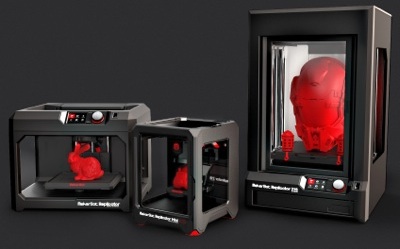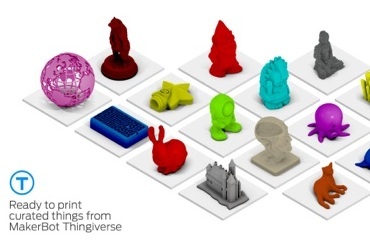Three dimensional printing has surged in popularity among consumers and manufacturers alike as costs come down and the range of available applications expands. In five years, the global 3D printing market is expected to reach $7.2 billion, up from $2.2 billion in 2013, according to a Transparency Market Research report released last week.
 The technology has incredible promise as companies and researchers experiment with printing everything from entire houses and cars, to synthetic meat and body parts. Just last week surgeons reconstructed a baby’s skull using a 3D printed template.
The technology has incredible promise as companies and researchers experiment with printing everything from entire houses and cars, to synthetic meat and body parts. Just last week surgeons reconstructed a baby’s skull using a 3D printed template.
At the forefront of the 3D printing boom for consumers is MakerBot, whose Linux-based Replicator printers sell for between $1,300 and $3,000 and are small enough to sit on your desktop. Their MakerWare design software runs on any platform and the Thingiverse online community allows more than 13,000 users to download or upload designs in an open source, collaborative model for do-it-yourself manufacturing, according to a sponsored post in The Atlantic.
Though printing a hand is impressive, and increasingly a reality, MakerBot is aiming for a different kind of revolution. They want to make 3D printing more accessible and user friendly to individuals to create and model their own ideas. With wider access to creative tools also comes a philosophy of creation that emphasizes fast iteration and prototyping, failing and adapting. That drives innovation.
“Tools like Linux or the MakerBot empower people,” said Anthony Moschella, Vice President of Product at MakerBot. “Platforms like Beaglebone and the Raspberry Pi have enabled a new generation of people to start developing quickly and easily on a Linux system. MakerBot is a similar analogy in how people create physical parts. It brings a new level of accessibility to the creative community.”
Powered by Linux
It’s fitting, then, that their technology is also based on Linux. Their latest generation of Replicators, announced at CES in January (along with a new digital store), contain TI ARM9 processors running MakerBot’s own embedded Linux operating system based on TI’s Angstrom distribution.
MakerBot chose Linux for its built-in support of all of the machine’s peripherals, including ethernet, USB, a video driver for their display, and wi-fi. That significantly sped up the development process by allowing them to focus more on the rich, customer-facing features written in upper-level languages like Python,  Moschella said.
Moschella said.
They also get a lot of portability with Linux, Moschella said. Their middleware can be developed on a desktop and run on an embedded system or vice versa. And the available pool of talented developers who know embedded Linux was greater than with alternatives such as ROS, he said.
“It’s the right way to architect embedded systems like this. To do it otherwise is to take on a huge support program that’s going to slow your development cycle,” Moschella said. “To do it with pure embedded code on a microcontroller, or not using an operating system, is significantly magnifying your development work.”
New for this year, MakerBot is focusing on how the overall system flow works, enabled by the embedded Linux platform. Their newest 3D printers have improved connectivity, for example, so users can download objects from the digital store and content will go directly to the MakerBot, Moschella said.
“There’s so much stuff coming,” he said. “This technology is in its infancy.”


